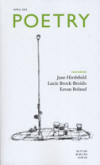Poetry – April 2013
If any magazine could create a mythology in one edition it would be Poetry. To accomplish this in one issue is next to miraculous, but this is what they have done in the April 2013 issue. Christian Winman and a small cast of editors make their work look effortless, the selections of work by established poets speaking for a larger humanity.
If any magazine could create a mythology in one edition it would be Poetry. To accomplish this in one issue is next to miraculous, but this is what they have done in the April 2013 issue. Christian Winman and a small cast of editors make their work look effortless, the selections of work by established poets speaking for a larger humanity.
The inside cover features a poem by Anslem Hollo (1934–2013). First published in the longstanding journal in January of 1969, the untitled, nine-line poem reminds us that poetry is timeless and always relevant. It also sets a tone for the issue, a memorial to the past and a mythology that suits the present.
Reading this issue should be compulsory for writers and poets even if the only pages read are the ones containing the three sonnets by Adam Kirsch accompanied by photographs. Kirsch’s all-encompassing statement in the last line of “Revolutionaries, 1929” provides readers with an enduring truth: “Everything that is burnable must burn.” Within his sonnets are the truths of human existence laid bare in the photographs and the words he puts to them.
The work of the universe, present and significant, emanates from most of the issue’s poems. The relationship between working on earth and becoming Godlike is evident in the memorialized poem and weaves its way metaphorically through each, ending with Jamaal May’s poetic treatise on thunder in “Hum for the Bolt.” The ominous last line, “I am this far. I am this close,” is a portent of how things may or may not come to fruition.
Subsequent poems hearken the reader back to the overarching theme, as in poem after poem, the past and present merge into one story, one meaning, through allusion, imagery, and astute storytelling. References to Polyphemus, Rome, and the proverbial Fox and Grapes help us anchor meaning in our own storytelling past; combined with images of suffering, death, and everyday life, the collection of poems in this issue culminate in the lovely gifts of Eavan Boland which retrace personal history and make it universal.
All of the mythologizing and images of the gods in this issue are followed by a commemoration of the publication of Ezra Pound’s “A Few Don’ts by an Imagiste,” published in the March 1913 issue of Poetry. The three updated versions of Pound’s essay by Marjorie Perloff, William Logan, and Sina Queyras contain lines that, if ever let out into the world of social media, would become memes for sure, perhaps superimposed over pictures of kittens in berets with quills in their paws. A few I would like to add to my own office wall. Perloff’s mini-essay explores Pound’s “Don’ts” through Frank O’Hara and comes up with five rules for poets, any of which could be a cynical version of Rilke’s “Letters to a Young Poet.” Logan and Queyras have the stuff that memes are made on, rules that few poets these days seem to heed: “Don’t think what you have to say is important. The way you say it is what’s important. What you have to say is rubbish.” and “You might love a sonnet, so love the sonnet. It doesn’t mean you have to write one.” Reminders to treat the art of writing poetry as an art whether Tweeting, Facebooking, or writing it down on (gasp!) paper.
My time with this month’s issue of Poetry was time well spent; I’m going in again.
[www.poetrymagazine.org]





